Loading ...
Loading ...
Loading ...

259
15. Advanced Configuration
Target Specification
PowerMan target hostnames may be specified as comma-separated or space-separated hostnames or host ranges. Host
ranges are of the general form: prefix[n-m,l-k,...], where n < m and l < k, etc. This form should not be confused with regular
expression character classes (also denoted by ‘’[]’’). For example, foo[19] does not represent foo1 or foo9, but rather
represents a degenerate range: foo19.
This range syntax is meant only as a convenience on clusters with a prefix NN naming convention. Range specification should
not be considered necessary; the list foo1,foo9 could be specified as such, or by the range foo[1,9].
Some examples of PowerMan targets include:
Power on hosts bar,baz,foo01,foo02,...,foo05: powerman --on bar baz foo[01-05]
Power on hosts bar,foo7,foo9,foo10: powerman --on bar,foo[7,9-10]
Power on foo0,foo4,foo5: powerman --on foo[0,4-5]
As a reminder, some shells will interpret brackets ([ and ]) for pattern matching. Depending on your shell, it may be necessary
to enclose ranged lists within quotes. For example, in tcsh, the last example above should be executed as:
powerman --on “foo[0,4-5]”
15.9.2 Pmpower tool
The pmpower utility is a high-level tool for manipulating remote preconfigured power devices connected to the console
server via serial or network connection. The PDU, UPS and IPMI power devices are variously controlled using the open
source PowerMan, IPMItool or Network UPS Tools. Tripp Lite’s pmpower utility arches over these tools so devices can be
controlled through the one command line:
pmpower [-?h] [-l device | -r host] [-o outlet] [-u username] [-p password] action
-?/-h This help message.
-l The serial port to use.
-o The outlet on the power target to apply to.
-r The remote host address for the power target.
-u Override the configured username.
-p Override the configured password.
on This action switches the specified device or outlet(s) on.
off This action switches the specified device or outlet(s) off.
cycle This action switches the specified device or outlet(s) off and on again.
status This action retrieves the current status of the device or outlet.
Examples:
To turn outlet 4 of the power device connected to serial port 2 on: # pmpower -l port02 -o 4 on
To turn an IPMI device off located at IP address 192.168.1.100 (where username is ‘root’ and password is ‘calvin’: #
pmpower -r 192.168.1.100 -u root -p calvin off
Default system power device actions are specified in /etc/powerstrips.xml. Custom power devices can be added in /etc/
config/powerstrips.xml. If an action is attempted which has not been configured for a specific power device, pmpower will
exit with an error.
Loading ...
Loading ...
Loading ...
